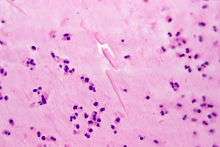Charcot–Leyden crystals
Charcot–Leyden crystals are microscopic crystals composed of eosinophil protein galectin-10 found in people who have allergic diseases such as asthma or parasitic infections such as parasitic pneumonia or ascariasis.

Appearance
Charcot–Leyden crystals are composed of an eosinophilic lysophospholipase binding protein called Galectin -10. They vary in size and may be as large as 50 µm in length.[1] Charcot–Leyden crystals are slender and pointed at both ends, consisting of a pair of hexagonal pyramids joined at their bases.[1] Normally colorless, they are stained purplish-red by trichrome.
Clinical significance
They are indicative of a disease involving eosinophilic inflammation or proliferation, such as is found in allergic reactions (asthma, bronchitis, allergic rhinitis and rhinosinusitis) and parasitic infections such as Entamoeba histolytica, Necator americanus, and Ancylostoma duodenale.
Charcot–Leyden crystals are often seen pathologically in patients with bronchial asthma.[2]
History
Friedrich Albert von Zenker was the first to notice these crystals, doing so in 1851, after which they were described jointly by Jean-Martin Charcot and Charles-Philippe Robin in 1853,[3] then in 1872 by Ernst Viktor von Leyden.[4][5]
See also
- Curschmann's Spirals
References
- Rodriguez, Rene A.; Sarmiento, Ladys; Rodriguez, Gerzain (18 January 1998). "Los cristales de Charcot-Leyden" [Charcot–Leyden crystals]. Revista Biomedica (in Spanish). Archived from the original (pdf) on 7 September 2017. Retrieved 26 June 2019.
Los cristales de Charcot-Leyden son estructuras derivadas de los eosinófilos y de los basófilos, de moríología característica: en los frotes o en los cortes histológicos aparecen como cristales hexagonales, bipiramidales, de diversostamaños, intensamente eosinófilos con la coloración de hematoxilina-eosina, fácilmente identificables con el objetivo 1OX
- Allen, Judith E.; Sutherland, Tara E.; Becker, Lydia (24 May 2019). "Crystal-clear treatment for allergic disease". Science. 364 (6442): 738–739. Bibcode:2019Sci...364..738A. doi:10.1126/science.aax6175. PMID 31123126.
On page 751 of this issue, Persson et al. (1) confirm anecdotal evidence that CLCs are a key feature of severe asthma and chronic rhinosinusitis with nasal polyps. They demonstrate that the crystals, but not the soluble proteins, are powerful promoters of allergic inflammation and can be targeted with crystal-dissolving antibodies to reverse disease symptoms.
- J. M. Charcot, C. P. Robin: Observation de leucocythémie. Comptes rendus de la Société de biologie, Paris, 1853, 44.
- Ernst Victor von Leyden: Zur Kenntnis des Asthma bronchiale. [Virchows] Archiv für pathologische Anatomie und Physiologie, und für klinische Medizin, Berlin, 1872, 54: 324-344; 346-352.
- J. Y. Su: A Brief History of Charcot-Leyden Crystal Protein/Galectin-10 Research. Molecules, 2018, 23(11), 2931.